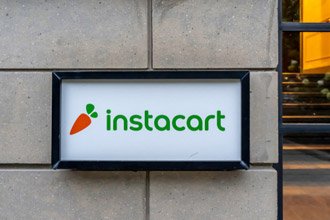Instacart recently consulted with investment banks ahead of a rumored IPO in early 2021. This would be an attempt by the company to profit further from a pandemic boom in the grocery delivery business.
2020 had a difficult start for IPO investing, with something of a drought while economies were locked down. But as communities began to get situated and lockdown measures began to ease, the 48% drop in IPO activity began to turn around again.

Fall IPO highlights for the year featured one of the biggest software IPOs of all time in Snowflake Inc. (NASDAQ: SNOW) and anticipation of what could be the largest IPO of all time in Jack Ma's Ant Group.
Now, the Instacart IPO is expected to be one of the largest in the United States next year. It's set to compete directly with Doordash, a delivery company that recently expanded to grocery delivery. Doordash also plans to go public before the end of 2020.
With that in mind, let's take a look at whether Instacart is a buy after the IPO.
What Is Instacart?
Instacart is an app-based grocery delivery and pick-up service. The company operates in both the United States and Canada.
It was founded in 2012 by a former Amazon.com Inc. (NASDQ: AMZN) employee and is currently headquartered in San Francisco.
Instacart was one of the first companies to start carving into the grocery delivery niche. In 2015, it started to encourage shoppers at different stores to become part-time employees in Chicago, Boston, Atlanta, Miami, and D.C.
The shopping angle is what separated it from other "delivery" competitors in the gig economy, like DoorDash, Grubhub, Postmates, and Uber Eats.
Something that could make investors question Instacart is the fact that its niche is open for penetration from these indirect competitors - both DoorDash and Postmates have adopted grocery delivery programs.
Instacart has also faced conflicts with its gig workers, similar to those faced by Uber Technologies Inc. (NASDAQ: UBER) and Lyft Inc. (NASDAQ: LYFT). The issues revolve around whether Instacart "shoppers" should be treated as employees or contractors, how much they should be paid, etc.
Despite all this, Instacart had a phenomenal year during the COVID-19 outbreak. Here's why there might be some promise in the stock once it goes public...
What the Instacart Financials Say
Instacart has grown rather quickly since only being valued at $3.4 billion in 2017. It was able to double that valuation through fundraisers in 2018, to $7.6 billion.
In June 2020, the company was valued at $13.8 billion following a fundraiser that also added $1 billion to its balance sheet.
More recently, Instacart raised $200 million in new funding from Valiant Capital Management and D1 Capital. The company is now valued at $17.7 billion in total.
In April, Instacart reported 300% growth in demand year over year. In an August report, demand had grown 274% year over year.
Now, Instacart is not very far behind Walmart in online delivery sales.
The company also grew from 200,000 to 350,000 customers.
That is partly due to the fact that Instacart has spent 2020 adding new features like "fast & flexible" and "order ahead" options that would help the company better prioritize orders.
More on how Instacart's front office has boosted the company as of late...
Instacart Business Model and Partnerships
Instacart users can now provide a range of days they are willing to receive their groceries. This was mostly a marketing opportunity where they could advertise "faster" options while leaving it up to customers to identify themselves as willing to wait longer or not.
Another new feature allowed customers to order their groceries up to two weeks in advance - before, it was only one week.
Instacart has partnerships with over 500 retailers. Walmart is one of those - it initially had a pilot program in California and Oklahoma with the retail company.
Association with a big name like Walmart could be great for this company's exposure.
Through all of this successful front office activity, Instacart has been able to distinguish itself in the competitive West Coast gig economy.
Still, there remains the pressure from gig economy employees to raise tip minimums and treat "shoppers" more like employees. A California law went into effect in January 2020 to limit the number of independent contractors businesses can hire.
This could affect Instacart, but we are still yet to see whether companies like this will respond with creative loopholes.
Finally, here's whether or not Instacart is a buy after the IPO or not.
Should You Buy Instacart Stock After the IPO?
It's often prudent to watch an IPO stock for a few months before buying.
The months around an IPO are typically filled with hype. It can be a good look for an underwriter and any private investors to sell the first shares at a high price - though not too high.
A storm of excitement can pump the stock even further, only to send it crashing later.
This doesn't always happen, but it's worth noting for the unpredictable gig economy investment.
The Lyft IPO was a classic example of this. The stock has lost around 70% of its price since its IPO in March 2019.
Instacart's demand growth is a good sign that it may not fall into that territory. But the rise of Doordash in the grocery delivery service could be a bad sign for Instacart. The company could also have competition from Grubhub and Uber Eats.
Competition has been one of the main items driving down the Lyft stock, as Lyft has been forced into a price war with Uber. Since the ride-hailing service and related technologies are also still in infancy, it can be hard to know what the future will look like for each stock.
The same can be said about grocery delivery. It's possible that a "winner" in this industry could come out on top and absorb all the competition. We almost saw that when Uber tried to acquire Grubhub. Now that it failed, it's going after Postmates.
While Instacart has performed well in the near term, you want to make sure you are watching this industry closely and making the most informed decision possible.
You Could Make Your Portfolio "Recession-Proof" with This System
While most investors watched their hard-earned money evaporate during the 2008 recession, Andrew Keene collected thousands per week by developing the ultimate indicator.
He used it to identify the moves all the big players were quietly making... putting him in the know weeks before others caught on.
Today, he's spilling the beans so that you too can turn any market condition into profits!
Follow Money Morning on Facebook and Twitter.
About the Author
Mike Stenger, Associate Editor for Money Morning at Money Map Press, graduated from the Perdue School of Business at Salisbury University. He has combined his degree in Economics with an interest in emerging technologies by finding where tech and finance overlap. Today, he studies the cybersecurity sector, AI, streaming, and the Cloud.



